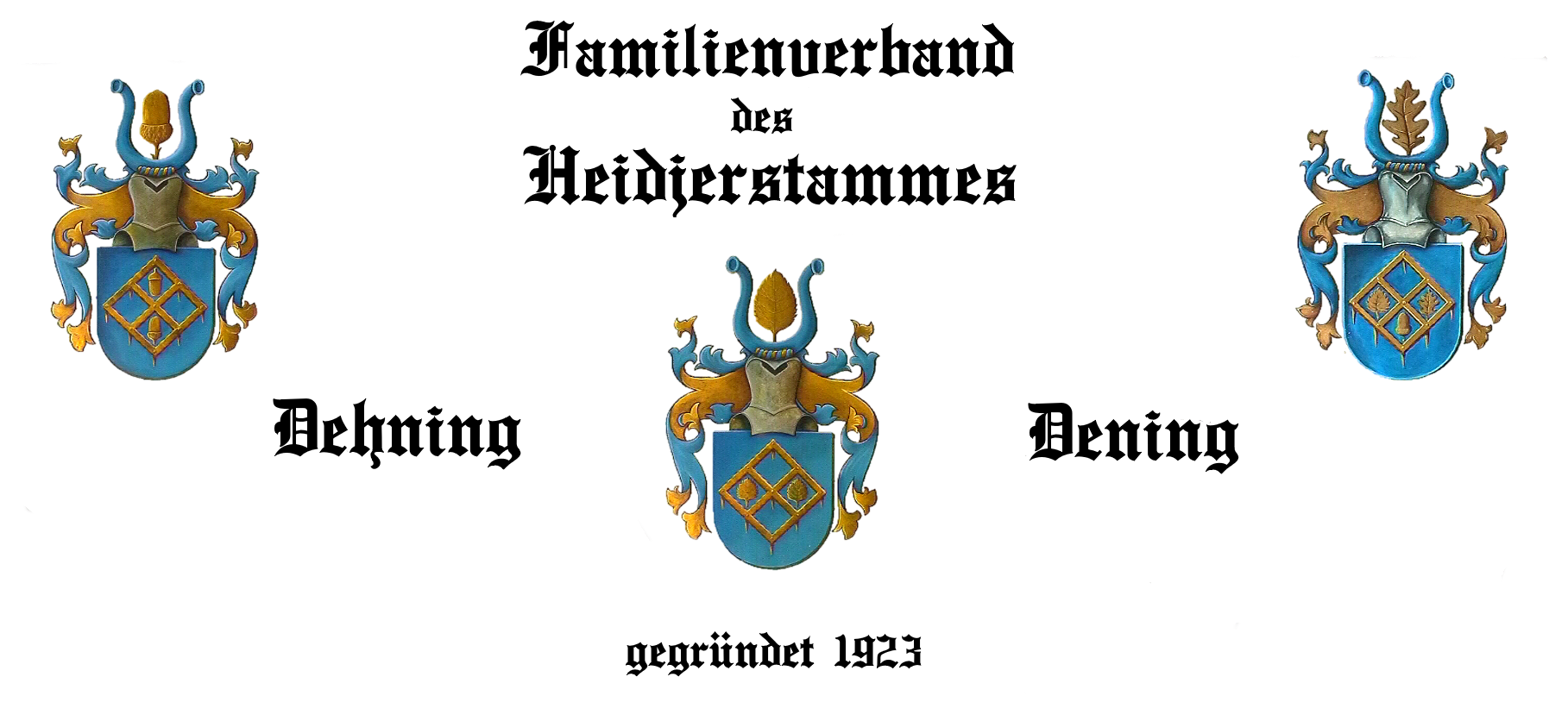At the reunion in 1953 the question arose if we should have a coat of arms as a sign of our belonging together. The reason that it took many years until they seriously thought of a coat of arms was that they wanted to find out if there was any mark, any brand or sign used by a Dehning farmer. But there was nothing, the peasants living in the Lüneburger Heide didn’t have any special family signs. So Dr. Gustav Dehning and his friend and successor as chairman, Heinrich Dehning, began to think about what a coat of arms was to look like.
There are strict rules if it is to be officially recognized and legally registered: There has to be a shield and on top of it a helmet with the helmet decoration over it. Normally you have blue and golden ribbon-like streamers round or behind the helmet and the fastening of the streamers on the helmet is covered by a wreath. (About the origin and development of the coat of arms see our newsletter of June 1998) Within these main parts you are free to choose your individual pictures or symbols. They soon agreed that the coat of arms should be a speaking one, i.e. it should tell us that our ancestors were peasants (farmers). So they chose a harrow and for the helmet decoration an acorn as there are many oak trees round the farmhouses.
Soon Gustav and Heinrich Dehning found out that according to heraldic principles one coat of arms for all Dehnings was not possible because of the following situation:
As far as we know all Dehnings are descendants of the Dehnings who lived in the two farmhouses Westerendshof in Beckedorf and Dehnernhof in Dehnernbockel and who lived in the village Bergen, all three in the Lüneburger Heide. We can assume that all Dehnings have a common root, but the appearing of our name in these places is so long ago (about 1600) that we haven′t got any document to prove it. As there is the rule: ‘One coat of arms for one lineage′, we have to have three coat of arms. Thus they had to find two distinguishing marks (pictures, signs) for the then known two lineages. The Beckedorfer Stamm (lineage) got the acorn and for the Dehnernbockeler Stamm they chose a beechleaf. (The meaning of ′-bockel′ is beech.) After the discovery of the third lineage in 2000 a third coat of arms got an oakleaf instead of the acorn or beech leaf respectively.
Today many Dehnings have a coat of arms as a sign that they belong to an old and large family. With a nice frame a colored coat of arms is a beautiful picture, too. You want to have one? Please contact Hans J.Dehning, Bremen.
 Division of the Lineages into Lines Division of the Lineages into Lines
Division of the Lineages into Lines Division of the Lineages into Lines
Almost all Dehnings are descendants of the Dehnings living on the two farms in the villages Beckedorf and Dehnernbockel and in the village Bergen. As we can′t prove that they are descendants of one single root, we have got the three lineages: Beckedorfer Stamm (= Lineage) Dehning I , Dehnerbockeler Stamm (= Lineage) Dehning II and Bergener Stamm (= Lineage) Dehning III.
As there were so many Dehning families, Heinrich Dehning (1903-1979) subdivided them into lines in order to show which families are closely connected. He named the lines after the village where the first of the line lived or after the name of the first. The name of the line always shows where the descendants come from or who was the first of the line. (There is no division of the Bergener Lineage as there is only one line.)
He divided the Beckedorfer Lineage (Dehning I) into 8 lines and the Dehnernbockeler Lineage (Dehning II) into 22 lines.
We know of 5 American Dehning-lines, 4 of them belong to the Dehnernbockeler Lineage (Dehning II), and one belongs to the Beckedorfer Lineage (Dehning I). They are sub-lines of 5 German lines.
